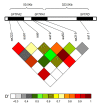Influence of genetic variability at the surfactant proteins A and D in community-acquired pneumonia: a prospective, observational, genetic study
- PMID: 21310059
- PMCID: PMC3221990
- DOI: 10.1186/cc10030
Influence of genetic variability at the surfactant proteins A and D in community-acquired pneumonia: a prospective, observational, genetic study
Abstract
Introduction: Genetic variability of the pulmonary surfactant proteins A and D may affect clearance of microorganisms and the extent of the inflammatory response. The genes of these collectins (SFTPA1, SFTPA2 and SFTPD) are located in a cluster at 10q21-24. The objective of this study was to evaluate the existence of linkage disequilibrium (LD) among these genes, and the association of variability at these genes with susceptibility and outcome of community-acquired pneumonia (CAP). We also studied the effect of genetic variability on SP-D serum levels.
Methods: Seven non-synonymous polymorphisms of SFTPA1, SFTPA2 and SFTPD were analyzed. For susceptibility, 682 CAP patients and 769 controls were studied in a case-control study. Severity and outcome were evaluated in a prospective study. Haplotypes were inferred and LD was characterized. SP-D serum levels were measured in healthy controls.
Results: The SFTPD aa11-C allele was significantly associated with lower SP-D serum levels, in a dose-dependent manner. We observed the existence of LD among the studied genes. Haplotypes SFTPA1 6A(2) (P = 0.0009, odds ration (OR) = 0.78), SFTPA(2) 1A(0) (P = 0.002, OR = 0.79), SFTPA1-SFTPA2 6A2-1A(0) (P = 0.0005, OR = 0.77), and SFTPD-SFTPA1-SFTPA(2)C-6A2-1A(0) (P = 0.00001, OR = 0.62) were underrepresented in patients, whereas haplotypes SFTPA2 1A(10) (P = 0.00007, OR = 6.58) and SFTPA1-SFTPA2 6A(3)-1A (P = 0.0007, OR = 3.92) were overrepresented. Similar results were observed in CAP due to pneumococcus, though no significant differences were now observed after Bonferroni corrections. 1A(10) and 6A-1A were associated with higher 28-day and 90-day mortality, and with multi-organ dysfunction syndrome (MODS) and acute respiratory distress syndrome (ARDS) respectively. SFTPD aa11-C allele was associated with development of MODS and ARDS.
Conclusions: Our study indicates that missense single nucleotide polymorphisms and haplotypes of SFTPA1, SFTPA2 and SFTPD are associated with susceptibility to CAP, and that several haplotypes also influence severity and outcome of CAP.
Figures



Similar articles
-
Genetic Association of Pulmonary Surfactant Protein Genes, SFTPA1, SFTPA2, SFTPB, SFTPC, and SFTPD With Cystic Fibrosis.Front Immunol. 2018 Oct 2;9:2256. doi: 10.3389/fimmu.2018.02256. eCollection 2018. Front Immunol. 2018. PMID: 30333828 Free PMC article.
-
Surfactant protein A genetic variants associate with severe respiratory insufficiency in pandemic influenza A virus infection.Crit Care. 2014 Jun 20;18(3):R127. doi: 10.1186/cc13934. Crit Care. 2014. PMID: 24950659 Free PMC article.
-
Correlation analysis between single nucleotide polymorphisms of pulmonary surfactant protein A gene and pulmonary tuberculosis in the Han population in China.Int J Infect Dis. 2014 Sep;26:31-6. doi: 10.1016/j.ijid.2014.03.1395. Epub 2014 Jun 28. Int J Infect Dis. 2014. PMID: 24984162
-
Differential Regulation of Human Surfactant Protein A Genes, SFTPA1 and SFTPA2, and Their Corresponding Variants.Front Immunol. 2021 Nov 30;12:766719. doi: 10.3389/fimmu.2021.766719. eCollection 2021. Front Immunol. 2021. PMID: 34917085 Free PMC article. Review.
-
Genetic variant associations of human SP-A and SP-D with acute and chronic lung injury.Front Biosci (Landmark Ed). 2012 Jan 1;17(2):407-29. doi: 10.2741/3935. Front Biosci (Landmark Ed). 2012. PMID: 22201752 Free PMC article. Review.
Cited by
-
Differences in serum SP-D levels between German and Japanese subjects are associated with SFTPD gene polymorphisms.BMC Med Genet. 2014 Jan 8;15:4. doi: 10.1186/1471-2350-15-4. BMC Med Genet. 2014. PMID: 24400879 Free PMC article.
-
Host genetic variability and pneumococcal disease: a systematic review and meta-analysis.BMC Med Genomics. 2019 Sep 13;12(1):130. doi: 10.1186/s12920-019-0572-x. BMC Med Genomics. 2019. PMID: 31519222 Free PMC article.
-
Genetic Association of Pulmonary Surfactant Protein Genes, SFTPA1, SFTPA2, SFTPB, SFTPC, and SFTPD With Cystic Fibrosis.Front Immunol. 2018 Oct 2;9:2256. doi: 10.3389/fimmu.2018.02256. eCollection 2018. Front Immunol. 2018. PMID: 30333828 Free PMC article.
-
Single Nucleotide Polymorphisms Interactions of the Surfactant Protein Genes Associated With Respiratory Distress Syndrome Susceptibility in Preterm Infants.Front Pediatr. 2021 Oct 4;9:682160. doi: 10.3389/fped.2021.682160. eCollection 2021. Front Pediatr. 2021. PMID: 34671583 Free PMC article.
-
Risk of Post-Myocardial Infarction Pneumonia with Proton Pump Inhibitors, H2 Receptor Antagonists and Mucoprotective Agents: A Retrospective Nationwide Cohort Study.J Pers Med. 2022 Jan 9;12(1):78. doi: 10.3390/jpm12010078. J Pers Med. 2022. PMID: 35055393 Free PMC article.
References
-
- Mandell LA, Bartlett JG, Campbell GD, Dean NC, Dowell SF, File TM Jr, Musher DM, Niederman MS, Torres A, Whitney CG. Infectious Diseases Society of America/American Thoracic Society consensus guidelines on the management of community-acquired pneumonia in adults. Clin Infect Dis. 2007;44:S27–72. doi: 10.1086/511159. - DOI - PMC - PubMed
-
- Geertsma MF, Nibbering PH, Haagsman HP, Daha MR, van Furth R. Binding of surfactant protein A to C1q receptors mediates phagocytosis of Staphylococcus aureus by monocytes. Am J Physiol. 1994;267:L578–L584. - PubMed
Publication types
MeSH terms
Substances
LinkOut - more resources
Full Text Sources
Medical
Research Materials
Miscellaneous

